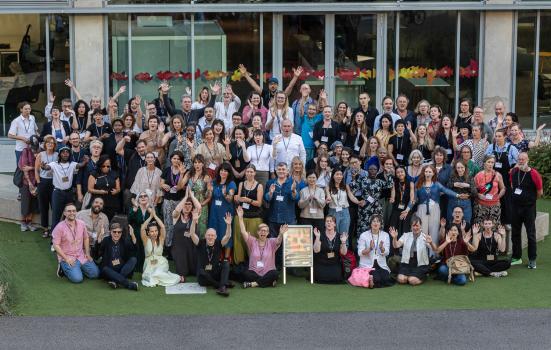What are artist residencies and what part could they play in nurturing inclusive and sustainable creative practice? A recent conference hosted by Acme addressed these questions, as Jon Opie reports.

Hydar Dewachi
More than 200 artists, arts residency hosts and artist mobility experts from across the world met last month in London for Mind the Gap: Designing residencies for everyone. Panel discussions, workshops and provocations gave them opportunity to discuss the themes of power and access, diversity, artist voices and partnership working.
Hosted by Acme in partnership with University College London, it was the first time the Res Artis conference had come to the UK and the first time the network had met in-person since the pandemic.
Acme is the largest provider of permanent long-term studios in London, with over 800 artists across 15 buildings. We are committed to reducing the practical challenges artists face by providing secure, affordable spaces and shorter-term residencies for UK and international artists to spend time to develop their practices and take creative risks.
So questions of who can access arts residencies and how can they be run equitably and sustainably are key for us. The conference title - Mind the Gap – references the mismatch between the good intentions of residency hosts and the often less-than-perfect day-to-day reality of artists’ experiences of residencies.
An unequal world
There were striking conversations about global and structural disparities in wealth and power. Residencies in Europe and America were seen as relatively well-funded and more accessible to artists from the global North who, comparatively, have better access to funding and support networks to take up these opportunities.
Manojna Yeluri from Artists at Risk Connection (international/India) cited the hierarchy of passports – some giving greater freedom of global mobility. And artists from Africa and Asia said they often found it difficult to travel in their own continents, let alone further afield, without financial and legal support.
Advice on funding and visa requirements is available from organisations such as On the Move (international/Belgium) and Arts Infopoint UK, but the intractability of the challenges of transnational working remains.
Accessible residencies
Throughout the conference there were inspiring models of how residencies could be more accessible. Sarah Cullen, founder of MOTHRA (Canada), an artist-parent residency project, showed how residencies can be designed to support parents to include children, while ensuring they were still creative and productive. This can shift how artists see their practice alongside caring responsibilities.
Underlying this case study was the inevitable fact that pressures persist for artists on residencies. They are rarely the complete break from reality that the ideal suggests. Sheryll Catto, CEO and Artistic Director of ActionSpace (UK), showcased models of residencies for artists with learning disabilities, where slow and bespoke working with strong communications between partners was essential to ensure the flourishing artistic practices.
These examples stood out in the overall conversation about accessibility, where the limited resources of those running residencies collided with artists’ precarities and needs. Two things that emerged clearly were the necessity for openness and communication before and during residencies for artists to be aware of what is offered/available, and the need for funding resources to enable a step change in practice.
Open and closed opportunities
Power structures determining who selects artists for residencies, and how, were at the heart of the conference conversations. An artist and writer from Singapore, Joey Chin, demonstrated the dynamics at play when artists apply for open call opportunities. She cited the time, hope and labour invested in the process, and the stacked odds against success.
She also commented that many opportunities are closed, either offered through small networks or appointments made by curators and programmers. Different selection methods were discussed, including by Victoria Tillotson of Watershed (UK) who launched a handbook with case studies on how arts organisations could use random selection to make opportunities fairer and less bureaucratic.
Artists’ agency
You can’t have arts residencies without artists, and we couldn’t hold the conference without artists. We ensured a significant proportion of speakers were artists, so that their voices were central. Co-creation was a central theme, especially with artists themselves embedded in the design of residencies.
On the final day, a panel of artists spoke powerfully of their need to retain agency in their residency experience, to feel confident and empowered to explore complex themes in their work in new and unfamiliar settings.
We also heard how some artists were at risk of persecution in their countries because of their activism and/or identities. International residencies can offer the safe spaces needed to find freedom and make work. Saber Bamatraf, an artist who fled Yemen and found a new home in Scotland, spoke about the work of Art27Scotland supporting migrant artists to assert their right to freely participate in the culture of their community.
Taiwan will host the 2024 conference where, no doubt, conversations will continue on how residency hosts and artists can collaborate transnationally to share knowledge about how to create fairer and more sustainable opportunities across different cultural and geographical contexts.
Jon Opie is Head of Artist Support at Acme Studios.
![]() acme.org.uk/
acme.org.uk/
![]() @acmestudios | @jonopie
@acmestudios | @jonopie




